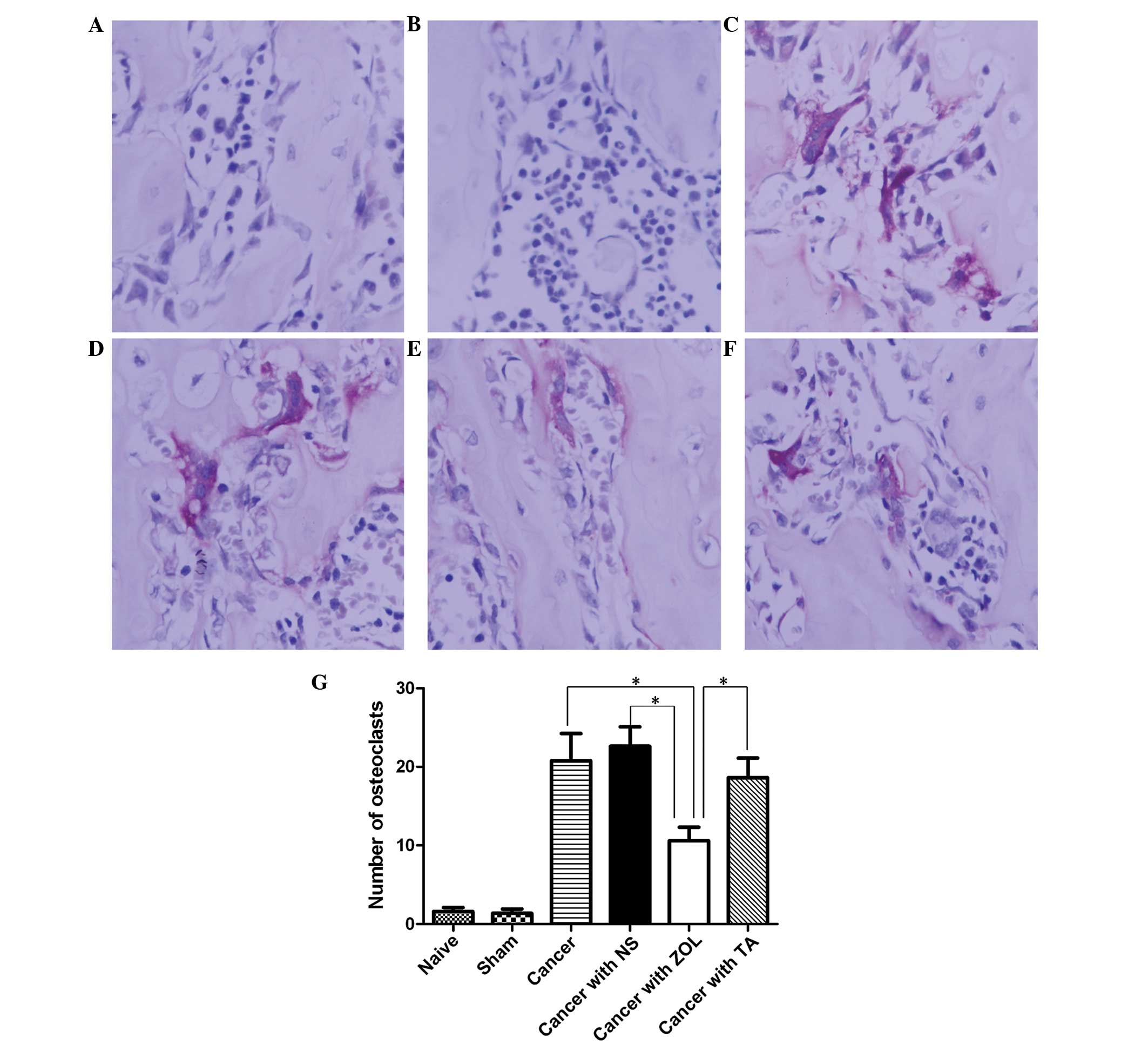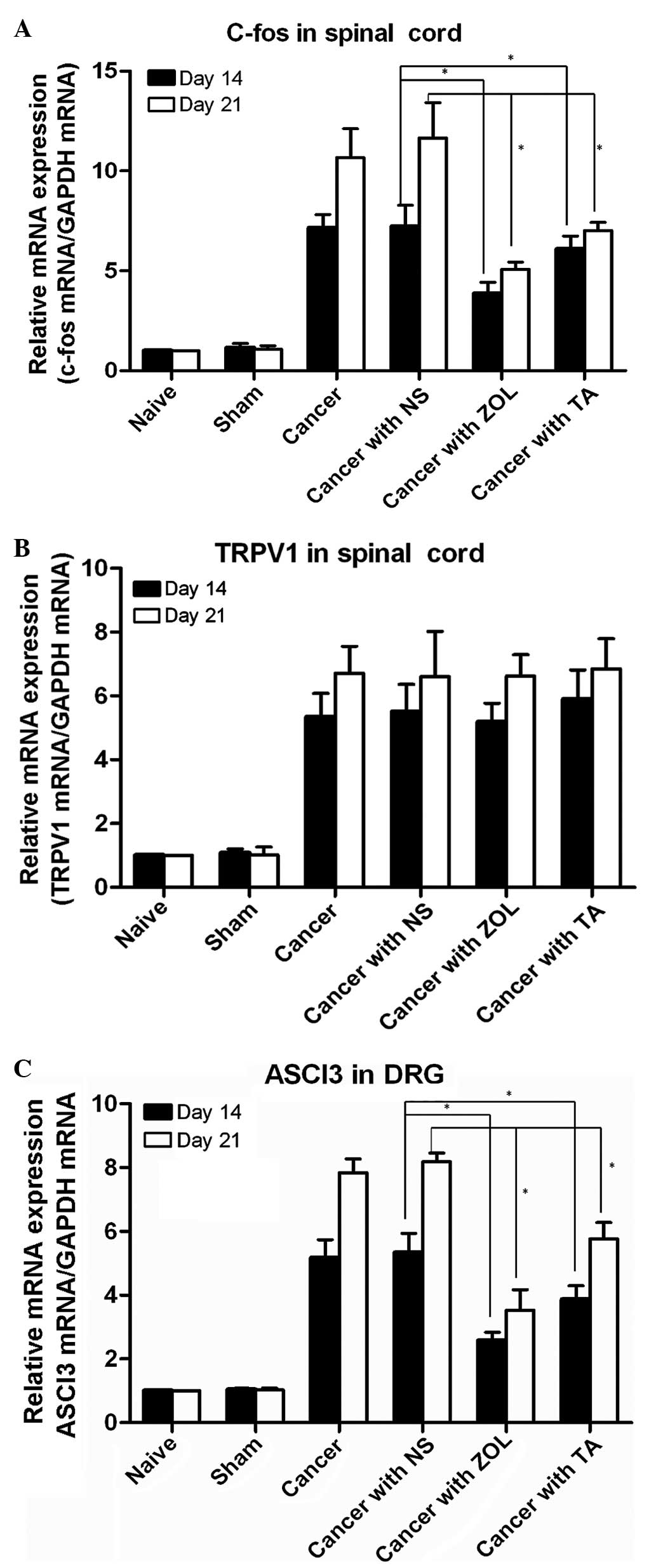|
1
|
Jimenez-Andrade JM, Mantyh WG, Bloom AP,
Ferng AS, Geffre CP and Mantyh PW: Bone cancer pain. Ann N Y Acad
Sci. 1198:173–181. 2010. View Article : Google Scholar : PubMed/NCBI
|
|
2
|
Middlemiss T, Laird BJ and Fallon MT:
Mechanisms of cancer-induced bone pain. Clin Oncol (R Coll Radiol).
23:387–392. 2011. View Article : Google Scholar
|
|
3
|
Fitch M, Maxwell C, Ryan C, Löthman H,
Drudge-Coates L and Costa L: Bone metastases from advanced cancers:
Clinical implications and treatment options. Clinical J Oncol Nurs.
13:701–710. 2009. View Article : Google Scholar
|
|
4
|
De Luca A, Lamura L, Gallo M, Daniele G,
D'Alessio A, Giordano P, et al: Pharmacokinetic evaluation of
zoledronic acid. Expert Opin Drug Metab Toxicol. 7:911–918. 2011.
View Article : Google Scholar : PubMed/NCBI
|
|
5
|
Yoh K, Kubota K, Ohmatsu H, Goto K, Niho S
and Ohe Y: Feasibility study of zoledronic acid plus
cisplatin-docetaxel as first-line treatment for advanced non-small
cell lung cancer with bone metastases. Anticancer Res.
32:4131–4135. 2012.PubMed/NCBI
|
|
6
|
Merz M, Komljenovic D, Zwick S, Semmler W
and Bäuerle T: Sorafenib tosylate and paclitaxel induce
anti-angiogenic, anti-tumour and anti-resorptive effects in
experimental breast cancer bone metastases. Eur J Cancer.
47:277–286. 2011. View Article : Google Scholar
|
|
7
|
Coleman RE, Major P, Lipton A, et al:
Predictive value of bone resorption and formation markers in cancer
patients with bone metastases receiving the bisphosphonate
zoledronic acid. J Clin Oncol. 23:4925–4935. 2005. View Article : Google Scholar : PubMed/NCBI
|
|
8
|
Takahashi S: Bone metabolic markers for
evaluation of bone metastases. Clin Calcium. 23:391–400. 2013.In
Japanese. PubMed/NCBI
|
|
9
|
Kobayashi S: Public health for scientific
study of society and health (11). Keypoints in ethical guidelines
for medical research. Nihon Koshu Eisei Zasshi. 58:909–912.
2011.
|
|
10
|
Doré-Savard L, Otis V, Belleville K, et
al: Behavioral, medical imaging and histopathological features of a
new rat model of bone cancer pain. PLoS One. 5:e137742010.
View Article : Google Scholar : PubMed/NCBI
|
|
11
|
Nieto FR, Cendán CM, Sánchez-Fernández C,
Cobos EJ, Entrena JM, Tejada MA, Zamanillo D, Vela JM and Baeyens
JM: Role of sigma-1 receptors in paclitaxel-induced neuropathic
pain in mice. J Pain. 13:1107–1121. 2012. View Article : Google Scholar : PubMed/NCBI
|
|
12
|
Gao M, Yan X and Weng HR: Inhibition of
glycogen synthase kinase 3β activity with lithium prevents and
attenuates paclitaxel-induced neuropathic pain. Neuroscience.
254:301–311. 2013. View Article : Google Scholar : PubMed/NCBI
|
|
13
|
Reeves BN, Dakhil SR, Sloan JA, et al:
Further data supporting that paclitaxel-associated acute pain
syndrome is associated with development of peripheral neuropathy:
North Central Cancer Treatment Group trial N08C1. Cancer.
118:5171–5178. 2012. View Article : Google Scholar : PubMed/NCBI
|
|
14
|
Ruiz-Medina J, Baulies A, Bura SA and
Valverde O: Paclitaxel-induced neuropathic pain is age dependent
and devolves on glial response. Eur J Pain. 17:75–85. 2013.
View Article : Google Scholar
|
|
15
|
Choi SS, Koh WU, Nam JS, Shin JW, Leem JG
and Suh JH: Effect of ethyl pyruvate on Paclitaxel-induced
neuropathic pain in rats. Korean J Pain. 26:135–141. 2013.
View Article : Google Scholar : PubMed/NCBI
|
|
16
|
Zhang H, Boyette-Davis JA, Kosturakis AK,
Li Y, Yoon SY, Walters ET and Dougherty PM: Induction of monocyte
chemoattractant protein-1 (MCP-1) and its receptor CCR2 in primary
sensory neurons contributes to paclitaxel-induced peripheral
neuropathy. J Pain. 14:1031–1044. 2013. View Article : Google Scholar : PubMed/NCBI
|
|
17
|
Brzeziński K: Chemotherapy-induced
polyneuropathy. Part I. Pathophysiology Contemp Oncol (Pozn).
16:72–78. 2012.
|
|
18
|
Grisold W, Cavaletti G and Windebank AJ:
Peripheral neuropathies from chemotherapeutics and targeted agents:
diagnosis, treatment and prevention. Neuro Oncol. 14(Suppl 4):
iv45–iv54. 2012. View Article : Google Scholar :
|
|
19
|
Hanson DA, Weis MA, Bollen AM, Maslan SL,
Singer FR and Eyre DR: A specific immunoassay for monitoring human
bone resorption: Quantitation of type I collagen cross-linked
N-telopeptides in urine. J Bone Miner Res. 7:1251–1258. 1992.
View Article : Google Scholar : PubMed/NCBI
|
|
20
|
Jablonka F, Schindler F, Lajolo PP,
Pinczowski H, Fonseca FL, Barbieri A, Massonetto LH, Katto FT and
Del Giglio A: Serum cross-linked n-telopeptides of type 1 collagen
(NTx) in patients with solid tumors. Sao Paulo Med J. 127:19–22.
2009. View Article : Google Scholar : PubMed/NCBI
|
|
21
|
Joerger M and Huober J: Diagnostic and
prognostic use of bone turnover markers. Recent Results Cancer Res.
192:197–223. 2012. View Article : Google Scholar : PubMed/NCBI
|
|
22
|
Buritova J, Tarayre JP, Besson JM and
Colpaert F: The novel analgesic and high-efficacy 5-HT1A receptor
agonist, F 13640 induces c-Fos protein expression in spinal cord
dorsal horn neurons. Brain Res. 974:212–221. 2003. View Article : Google Scholar : PubMed/NCBI
|
|
23
|
Jergova S and Cizkova D: Long-term changes
of c-Fos expression in the rat spinal cord following chronic
constriction injury. Eur J Pain. 9:345–354. 2005. View Article : Google Scholar : PubMed/NCBI
|
|
24
|
Sluka KA, Rasmussen LA, Edgar MM,
O'Donnell JM, Walder RY, Kolker SJ, Boyle DL and Firestein GS:
Acid-sensing ion channel 3 deficiency increases inflammation but
decreases pain behavior in murine arthritis. Arthritis Rheum.
65:1194–1202. 2013. View Article : Google Scholar : PubMed/NCBI
|
|
25
|
Salazar H, Jara-Oseguera A and Rosenbaum
T: The TRPV1 channel as a target for the treatment of pain. Rev
Neurol. 48:357–364. 2009.PubMed/NCBI
|
|
26
|
Neelands TR, Zhang XF, McDonald H and
Puttfarcken P: Differential effects of temperature on
acid-activated currents mediated by TRPV1 and ASIC channels in rat
dorsal root ganglion neurons. Brain Res. 1329:55–66. 2010.
View Article : Google Scholar : PubMed/NCBI
|















